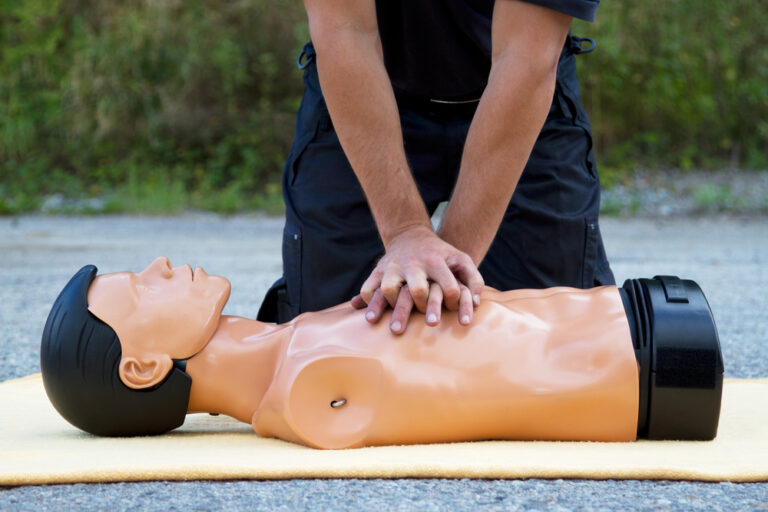


Imagine this happening. A person of about 50 years suddenly collapses in the middle of the pavement as he moves around. People around, flustered, don’t know if he’s just unconscious or worse. They try to locate his pulse but feel nothing.
Does he have a heart attack? Someone calls for an ambulance. But how long will it take for the trained first responders to arrive? And what must bystanders do till then?
This kind of scenario happens so often that there is a medical protocol for trained − or even lay people − to help save the precious minutes of the fallen person’s life when his life may be saved.
The procedure by which anyone can try to keep the person alive till trained help arrives is called Cardiopulmonary Resuscitation (or CPR). Of course, everyone needs to learn this critical type of first aid formally. But even if you’ve had no formal training, you can still help.
Learn more about CPR − and who knows how many lives you may help save with your alacrity and immediate response of the correct kind.
Since many cardiac arrest cases (heart attacks) could happen when people are alone in areas far away from home or hospital, some important medical bodies have joined together to form a universally acceptable CPR regimen to follow for helping fallen patients.
The instructions and training methods for Cardiopulmonary Resuscitation (CPR) have been devised based on an extensive review of the evidence performed by the International Liaison Committee on Resuscitation (ILCOR) and are published jointly by ILCOR, the American Heart Association (AHA), and the European Resuscitation Council (ERC).
The International Red Cross (and Red Crescent) follow the same standard protocol worldwide.
This life-saving CPR methodology is a boon for people who needn’t watch desperately as they witness someone collapsing with what seems like a heart attack. If they know the broad CPR guidelines, they can pitch in and help in the crucial life-reviving moments till formal help arrives.
To understand how CPR helps, we must first understand what happens to the human body when a person has a cardiac or pulmonary arrest.
According to a medically-reviewed article in VeryWellHealth.com by Rod Bouhard, the heart and lungs are the two organs most important for human survival. The heart pumps blood into the lungs, where it is purified with oxygen and then returned to the heart for circulation through the rest of the body, most importantly, the brain.
This heart-lung tandem can get stopped suddenly and become life-threatening in two ways:
In cardiac arrest cases, the idea behind CPR is to use chest compressions to imitate how the heart pumps. This could help revive the stopped heart or at least keep blood flowing throughout the body. In the case of lung stoppage, if some rescue-breathing is given to the patient through mouth-to-mouth resuscitation, it could help revive respiratory arrest.
The important thing is this: we can never say how long CPR needs to be given to revive the heart or lungs of a fallen patient. CPR is a challenging and exhausting procedure for the help-giver. Since every second is critical, it’s essential to call an ambulance before starting CPR. The sooner trained medical help arrives, the better.
If you’re ignorant of what’s involved in CPR, you may be afraid to do it to help a patient in dire need. But, remember, it’s always better to try (even with a bit of knowledge) than to do nothing at all. According to an article by the staff of Mayo Clinic, “The difference between doing something and doing nothing could be someone’s life.”
Everyone should be familiar with CPR, even if not formally trained. Here’s more advice on the different types of people with or without formal CPR training on how to help a needy patient.
If you’re not trained in CPR or are worried about giving more advanced techniques like rescue breaths, then at least provide hands-on CPR.
You need to clutch your palms and fingers of both hands, one on top of the other, and apply physical pressure on the patient’s chest, giving the patient uninterrupted chest compressions. You should ideally give 100 to 120 compressions a minute until paramedics arrive.
You don’t need to try rescue breathing. To make sure you are pressing the chest with the right timing, follow your movements to the rhythms of some popular songs … like the children’s nursery rhyme, “Row, Row, Row Your Boat” − or the famous song “Stayin’ Alive” by the Bee Gees.
If you’re well-trained, certified, and confident in your CPR ability, start the CPR − and between every 30 chest compressions, give two rescue breaths. This is usually the taught protocol.
See that the patient is in a shady and safe area with enough space. If a crowd is gathered, get someone to ask them to move a little away from the patient.
But don’t ask people to disperse. If they see you in action, they too will learn from the experience of watching you.
You may have all the skills learned long ago, but your skills may be rusty. If you’re not confident in your abilities, just do the chest compressions at a rate of 100 to 120 compressions a minute. Avoid rescue breathing. Keep going till medical help arrives.
But, promise yourself to go back to retrain and be up-to-the-minute on your skills when you next get the opportunity. What is the value of your earlier training if it’s not much use when it is most needed?
Considering CPR’s importance, very few people take the formal training and certification. Hospitals and medical bodies have taken several initiatives to heighten public awareness and to ask schools, colleges, offices, and businesses to introduce CPR training at their facilities to get more people formally trained and certified.
Apart from this, many people may not be aware that CPR can also be learned online. The online courses are usually less expensive, and they are self-paced.
For online courses, students may be asked to buy mannequins they can practice on, and then with the help of video instructions and other course materials, the courses would teach CPR methods in detail. In the end, students usually receive a certificate.
There are excellent in person and online courses from the Red Cross (and Red Crescent), the American Heart Association, the National CPR Foundation, and the American Academy of CPR and First Aid, among others.
Whichever way you choose to learn, in person or online, a follow-up refresher course is recommended at least every three years.
Let’s all solemnly commit to learning what’s needed to help anyone in a life-and-death situation. Here’s our clarion call you too can follow: “Be CPR-aware. Save lives. Be a Heartstrong Hero.”